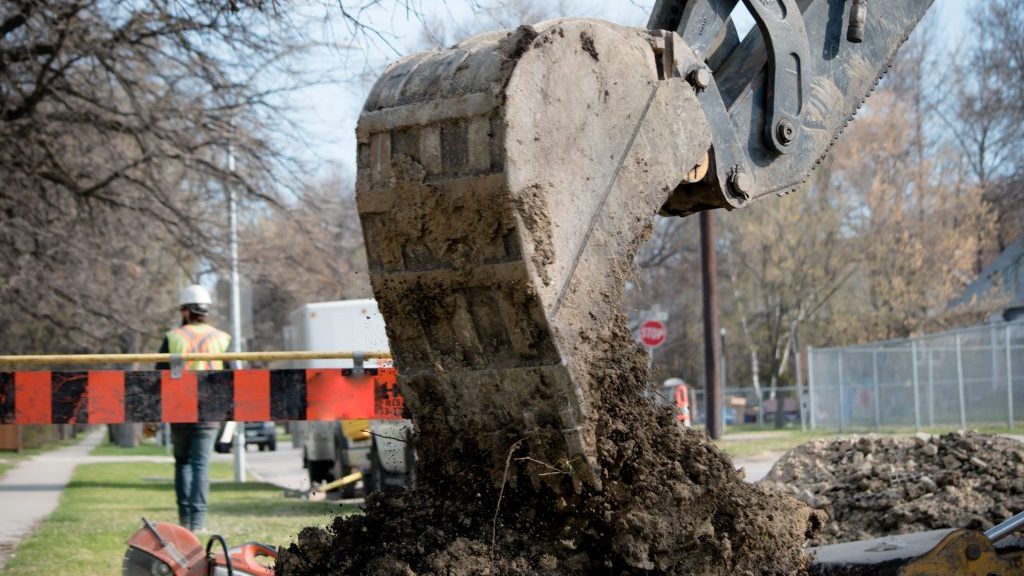Municipal leaders and stakeholders in Manitoba’s heavy construction industry are condemning the provincial government’s plan to cut funding for essential road and bridge repairs.
The Association of Manitoba Municipalities (AMM) and the Manitoba Heavy Construction Association (MHCA) are requesting that the province reinstate the Municipal Road and Bridge Program.
A record number of municipalities represented at an AMM convention in Winnipeg recently passed a resolution that calls on the government to reinstate the program to its former funding levels and notes cancelling it will have a devastating effect on infrastructure and the economy.
“Without the provincial support, municipal infrastructure will deteriorate at a higher pace,” said AMM executive director Joe Masi.
MHCA president Chris Lorenc concurs and said the heavy construction industry joins the AMM in supporting the restoration of core infrastructure investment by the provincial government.
“This program provides for investment in the maintenance and rehabilitation of existing rural municipal roads and bridges,” he said. “Delaying repairs accelerates their deterioration exponentially and, along with that, associated costs. It is penny wise, pound foolish and costs all of us more.”
The province announced in June that it planned to terminate the program. In 2017, the program made $14 million available to municipalities. This year it was cut to $2.25 million.
Ninety-seven per cent of the 137 municipalities at the AMM convention supported the resolution. The resolution asks the province to refrain from proceeding with plans to transition the municipal program into the Investing in Canada Infrastructure Program, and fully reinstate the funding.
“Municipalities are responsible for 60 per cent of Canada’s public infrastructure, yet they receive less than 10 cents of every tax dollar collected,” Masi said. “Our members need to close the infrastructure gap with the support from two other orders of government.”
Masi said municipalities are worried about the future because they rely on the funding to repair roads and bridges and the province has a municipal infrastructure deficit estimated to be more than $11 billion.
That infrastructure deficit, according to the AMM, amounts to a staggering $10,000 per Manitoban and it doesn’t include new infrastructure needs.
The program, which was developed in partnership with the AMM, provides 50/50 cost-shared funding for municipal road and bridge projects and allowed a single-window application process for municipalities.
AMM president Chris Goertzen said the program is essential for a better Manitoba because it has very little red tape, “which makes it an efficient way for municipalities to partner with the provincial government to build much-needed infrastructure in local communities across our province.”
Minister of Municipal Relations Jeff Wharton, who spoke at the AMM convention, issued a statement afterwards indicating he was considering the request to have a replacement program put in place.
He said the province has heard the concerns and is designing an improved infrastructure program for provincial investment in roads and bridges, but he offered no details on what the program might entail.
“We acknowledge the concerns and we understand the needs for reduction of red tape, predictable, stable and long-term funding,” he said in the statement.
Lorenc said he understands the need to cut expenditures and supports the government in its effort to achieve fiscal balance, but core infrastructure investment helps grow the economy.
The MHCA has joined forces with the Merit Contractors Association of Manitoba to get government to set up a panel of experts to take an in-depth look at how infrastructure is funded in the province.
“What we have recommended is that the province appoint a subject matter expert panel to review how infrastructure is funded now, and recommend how it should be funded going forward,” said Lorenc.
Between budget cuts and program under-expenditures, Lorenc said the province has cut the highways capital program by an unprecedented 55 per cent, and Manitoba faces an investment deficit of about $6 billion in its highways, bridges and related structures.
At current program levels, that accelerates the transportation system deterioration by up to $75 million annually which then grows exponentially, he said.
“At the end of the day, it costs all of us more to try to catch up.”
Lorenc said decades of past and continued neglect is only going to further deteriorate the condition and costs to repair public infrastructure.
“We wouldn’t ignore a crumbling basement in our house because it holds our home upright. Why then would we ignore infrastructure, the basement of our economy?”
Lorenc said sustained, strategic investment in infrastructure provides one of the highest rates of return to the economy by boosting GDP.
He said a 2015 Conference Board of Canada report for Manitoba, for example, verified that for every dollar the province invested in core infrastructure in 2014, $1.30 was returned to the economy.
“Sustained strategic investment in infrastructure is our economy’s health care program,” he said. “Removing that investment, hurts our economy in the broadest sense.”







Recent Comments
comments for this post are closed